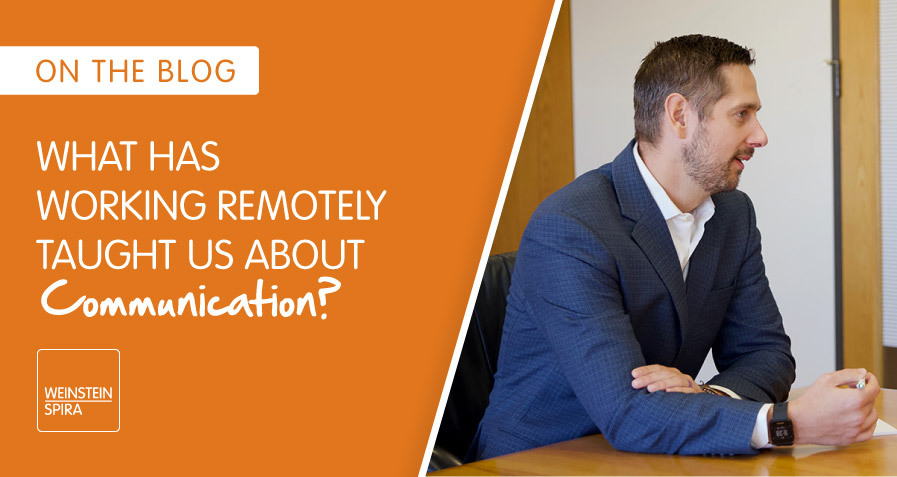After working from home for so many months, a big reveal for me and countless others has been the importance of communication—both casual communication and deliberate conversations that drive business excellence. That includes problem-solving, feedback sessions, regularly scheduled check-ins, etc. As a tax manager, mentor, and coach, I have always known that communicating with staff and clients is key to developing empowered work relationships. However, in the office I think we all took for granted that we would see each other in the hallway, while grabbing a cup of coffee, and at pre-arranged networking events/mixers. But without those opportunities, we were suddenly left to our own devices. Soft skills like communication were not typically factored into the work-at-home setup (computers, software, and virtual meeting technology were the focus).
Virtual Hand Raising
What I call “virtual hand-raising” is critical to getting your needs met from home. Without your manager peeking his/her head in your door daily to see how you are doing, it is up to you to bring any problems to their attention via a quick remote meeting or phone call. If not, you are left to struggle in silence— and that problem you fail to report gets bigger and bigger! Avoidance is not an option; stepping up and gathering the resources you need to solve a problem as soon as it occurs is the way to go. That requires timely communication with others, rather than waiting and allowing it to fester. So, keep raising your hand remotely, or in person when we return to the office, to get things resolved quickly.
Brainstorming
When isolated in a home office, it is always more difficult to engage others in a brainstorming session, considered to be a very effective means of results-oriented communication. Again, this is where you need to be deliberate in your communication and directly ask for others’ input. Even from home, teamwork generates new ideas and adds to positive project outcomes. Whether or not you are adept at setting up virtual meetings, it is easy to get a group together online via user-friendly tools. Once you can see each other in the “Hollywood Squares” mode, you will gain more confidence to speak up. Active participation is critical to such conversations.
Evaluation and Performance Feedback
In the distance work environment, it continues to be the manager’s responsibility to communicate with staff as to how they are measuring up to their goals and company expectations. This has been more challenging since ‘out of sight, out of mind’ tends to creep in, and it may be months before an issue is recognized. But in all fairness, your direct reports need feedback throughout the year, not just at annual review time. Deliberate check-ins are crucial to keep employee development on track, either from afar or face-to-face back in the office. Although it may be more difficult to connect remotely, it is still important to take a proactive approach and not wait until it is too late to correct a performance issue. Accountability goes along with communications to ensure your staff gets the support they need in order to develop and grow.
Honest, Authentic Communication
One should strive for open, honest and authentic communication as the gold standard when honing this interpersonal skill. Your co-workers, supervisors and clients will appreciate it now, and always—it literally sets you apart from others. That also means being honest with yourself. What are your strengths and weaknesses in communication? Do you need training to improve? One such training program I came across is Crucial Conversations®, offered by VitalSmarts. Their premise is that effective communication not only improves relationships, but it is linked to high-performance individuals and corporations. So, this is as good a time as ever to work on your communication and add it to your skillset.
Conclusion
Mapping what we learned from working remotely onto the physical work environment will take our communication skills to a new level. Instead of returning to closed door offices and slipping back into old habits, try adopting an open-door policy and make regular rounds throughout your office, even if it’s to simply say “hello” or “welcome back.”
We can all stand to improve by making that extra effort to keep the lines of communication going. If we do, it will continue to build trust and understanding in the post-COVID days ahead. And, it will be that much easier to have the tough conversations when the need arises. I have found that it really pays off to build strong relationships through continuous communication. People seem to be receptive to what I have to say, and they trust that I have their best interest in mind based on our history of conversations.
Remember, communication is a two-way street. Do not wait for the other person to initiate, be the one to start a conversation today! I suggest getting comfortable with being uncomfortable. You may not always know the right thing to say, but if you go with your gut feeling, you will be well on your way.



